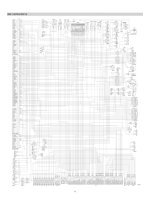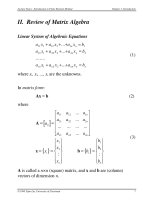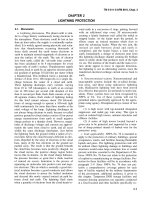Chapter 2 data interpretation
Bạn đang xem bản rút gọn của tài liệu. Xem và tải ngay bản đầy đủ của tài liệu tại đây (821.57 KB, 24 trang )
VIETNAM NATIONAL UNIVERSITY – HO CHI MINH CITY
UNIVERSITY OF TECHNOLOGY
FACULTY OF CHEMICAL ENGINEERING
Chemical Reaction Engineering
(Homogeneous Reactions in Ideal Reactors)
Mai Thanh Phong, Ph.D.
FCE – HCMC University of Technology
Chemical Reaction Engineering
Chapter 2. Interpretation of Batch Reactor Data
1. Rates of reaction
1.1. Description of reaction rates
Reaction rates depend usually in a complex manner on the concentrations, the
temperature and often on the effect introduced by catalysts:
r = f ( ci ,T, catalyst)
The order of a reaction is related to the concentration dependence. Typical
examples are:
Irreversible Reactions:
• First order:
A Products:
r = k(T)CA
k in [s-1]
• Second order:
A + B Products:
2A Products:
r = k(T)CACB
r = k(T)CA2
k in [m3 mol-1s-1]
k in [m3 mol-1s-1]
Mai Thanh Phong - HCMUT
Chemical Reaction Engineering
Apr 28, 2023
2
Chapter 2. Interpretation of Batch Reactor Data
Reversible Reactions:
• First order:
A R:
r = k1CA – k2CR
k in [s-1]
• Second order:
A + B R + S:
2A 2R:
r = k1CACB – k2CRCS
r = k1CA2 – k2CR2
k in [m3 mol-1s-1]
k in [m3 mol-1s-1]
2A R + S:
r = k1CA2 – k2CRCS
k in [m3 mol-1s-1]
A + B 2R:
r = k1CACB – k2CR2
k in [m3 mol-1s-1]
The dependency of the reaction rate on the temperature can be described using
Arrhenius law:
• EA is the activation energy of the reaction.
EA
k (T ) k0 exp
• ko is the pre-exponential factor (not dependent
RT
on
the reaction temperature
Apr 28, 2023
Mai Thanh Phong - HCMUT
Chemical Reaction Engineering
3
Chapter 2. Interpretation of Batch Reactor Data
1.2. Rate laws of simple reactions
In this section, rate equations of simple reactions and the corresponding
temporal change of concentration are analyzed. A closed system (isothermic,
batch reactor) and aconstant volume are assumed.
.2.1. Irreversible first-order reactions (Decomposition reactions)
A Products
The rate equation is:
1 dCi
r
kCi
i dt
(2.1)
With i is A and vi = -1, then:
dC A
r
kC A
dt
(2.2)
CA
The integration form:
Mai Thanh Phong - HCMUT
t
dC A
or
k dt
CA
C Ao
0
Chemical Reaction Engineering
CA
ln
kt(2.3)
C A0
Apr 28, 2023
4
Chapter 2. Interpretation of Batch Reactor Data
The eq. (2.3) leads to the temporal course of concentration cA.
With
C A C A0 e kt
(2.4)
C A0 C A
, the eq. (2.3) leads to:
XA
C A0
(2.5)
ln(1 X A ) ktor
X A 1 e kt
(2.6)
.2.2. Irreversible bimolecular-type second-order reactions
Consider the reaction (A + B Products) with corresponding rate equation
(2.7)
r=
Mai Thanh Phong - HCMUT
Chemical Reaction Engineering
Apr 28, 2023
5
Chapter 2. Interpretation of Batch Reactor Data
Noting that the amounts of A and B that have reacted at any time t are equal
and given by CA0XA, eq. (2.7) can be written in terms of XA as
(2.8)
r=
(2.9)
(2.10)
Mai Thanh Phong - HCMUT
Chemical Reaction Engineering
Apr 28, 2023
6
Chapter 2. Interpretation of Batch Reactor Data
After breakdown into partial fractions, integration, and rearrangement, the final
result in a number of different forms is
(2.11)
For the reaction: 2A Products, the defining second-order differential
equation becomes
(2.12)
r=
which on integration yields
(2.13)
Mai Thanh Phong - HCMUT
Chemical Reaction Engineering
Apr 28, 2023
7
Chapter 2. Interpretation of Batch Reactor Data
1.2.3. Empirical rate equations of nth order
When the mechanism of reaction is not known, we often attempt to fit the data
with an nth-order rate equation of the form
(2.14)
which on separation and integration yields
(2.15)
1.2.4. Zero-order reactions
Integrating and noting that CA
can never become negative,
we obtain directly:
Mai Thanh Phong - HCMUT
Chemical Reaction Engineering
(2.16)
Apr 28, 2023
8
Chapter 2. Interpretation of Batch Reactor Data
1.2.5. Irreversible Reactions in Parallel
Consider the simplest case, A decomposing by two competing paths
The rates of change of the three components are given by
(2.17)
(2.18)
(2.19)
Mai Thanh Phong - HCMUT
Chemical Reaction Engineering
Apr 28, 2023
9
Chapter 2. Interpretation of Batch Reactor Data
The k values are found using all three differential rate equations. First of all,
eq. (2.17), which is of simple first order, is integrated to give
(2.20)
Then dividing eq. (2.18) by eq. (2.19) we obtain the following
(2.21)
which integrated gives simply
(2.22)
Mai Thanh Phong - HCMUT
Chemical Reaction Engineering
Apr 28, 2023
10
Chapter 2. Interpretation of Batch Reactor Data
1.2.6. Irreversible Reactions in Series
Consider the reaction
Rate eqautions for the three components are
(2.23)
(2.24)
(2.25)
Mai Thanh Phong - HCMUT
Chemical Reaction Engineering
Apr 28, 2023
11
Chapter 2. Interpretation of Batch Reactor Data
Assuming that at t = 0, concentration of A is CA0, and no R or S present,
integration of eq. (2.23) gives
(2.26)
To find the changing concentration of R, substitute the concentration of A from
eq. (2.26) into the differential equation governing the rate of change of R, eq.
(2.24); thus
(2.27)
Solving the above differential equation gives
(2.28)
Mai Thanh Phong - HCMUT
Chemical Reaction Engineering
Apr 28, 2023
12
Chapter 2. Interpretation of Batch Reactor Data
Noting that
which eqs (2.26) and (2.28) gives
(2.29)
If k2 is much larger than k1, Eq. (2.29) reduces to
(2.30)
If k1 is much larger than k2, then
(2.31)
Thus, in general, for any number of reactions in series it is the slowest step that
has the greatest influence on the overall reaction rate.
Mai Thanh Phong - HCMUT
Chemical Reaction Engineering
Apr 28, 2023
13
Chapter 2. Interpretation of Batch Reactor Data
By differentiating Eq. (2.28) and setting dCRldt = 0, the maximum concentration
of R and the time at which it occours can be found:
(2.32)
(2.33)
Mai Thanh Phong - HCMUT
Chemical Reaction Engineering
Apr 28, 2023
14
Chapter 2. Interpretation of Batch Reactor Data
Figure 2.1 shows the general
characteristics of the
concentration-time curves
for the three components:
• A decreases exponentially,
• R rises to a maximum and
then falls,
• and S rises continuously, the
greatest rate of increase of S
occurring where R is a
maximum.
Eq. (2.26)
Eq. (2.29)
Eq. (2.28)
Eq. (2.33)
Eq. (2.30)
Figure 2.1. Typical concentration-time
curves for consecutive first-order
reactions.
Mai Thanh Phong - HCMUT
Chemical Reaction Engineering
Apr 28, 2023
15
Chapter 2. Interpretation of Batch Reactor Data
1.2.7. First-Order Reversible Reactions
The simplest case is the opposed unimolecular-type reaction
(2.34a)
Starting with a concentration ratio M = CR0/CA0 th e rate equation is
(2.34b)
At equilibrium dCA/dt = 0. Hence from Eq. (2.34) we find the fractional
conversion of A at equilibrium conditions to be
(2.35)
Mai Thanh Phong - HCMUT
Chemical Reaction Engineering
Apr 28, 2023
16
Chapter 2. Interpretation of Batch Reactor Data
and the equilibrium constant to be
(2.36)
Combining the above three equations we obtain, in terms of the equilibrium
conversion gives
(2.37)
Taking integration of the above equation, the following relation can be found:
(2.38)
Mai Thanh Phong - HCMUT
Chemical Reaction Engineering
Apr 28, 2023
17
Chapter 2. Interpretation of Batch Reactor Data
1.2.8. Second-Order Reversible Reactions
For the bimolecular-type second-order reactions
(2.39a)
(2.39b)
(2.39c)
(2.39d)
with the restrictions that CA0 = CB0, and CR0 = CS0 = 0, the integrated rate
equations for A and B are all identical, as follows
(2.40)
Mai Thanh Phong - HCMUT
Chemical Reaction Engineering
Apr 28, 2023
18
Chapter 2. Interpretation of Batch Reactor Data
2. Determination of kinetic parameters
2.1. Integral method
For the integral method, the concentration-time-course of one commponent is
measured.
A tipycal measurement is depicted in
CA
Figure 2.2.
CA0 *
After this measured data are compared
with theoretical integrated reaction rate
*
equation, for example:
*
C A C A0 e
*
kt
the unknown parameters can be calculated
by non-linear regression or using the
linearised form of the integrated rate
equation:
CA
ln
kt
C A0
Mai Thanh Phong - HCMUT
*
*
*
*
* *
* * *
t
Figure 2.2. Typical experimental
concentration-time-course
Chemical Reaction Engineering
Apr 28, 2023
19
Chapter 2. Interpretation of Batch Reactor Data
The measured data can be inllustrated in a ln(CA/CA0) vs. T diagram. The slope
of the straight line leads to the reaction rate constant (Figure 2.3).
2.6 of 2.3
Figure 2.3. Determination of the reaction rate constant k using the
integrated method in a linearised formulation
Mai Thanh Phong - HCMUT
Chemical Reaction Engineering
Apr 28, 2023
20









